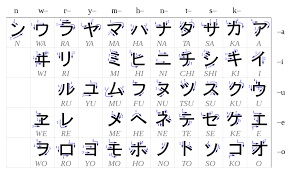|
|
| |
|
|
| |
|
|
|
|
| |
 |
| Table showing
hiragana characters. |
Katakana
Katakana is a Japanese script used for writing words
borrowed from other languages. It is easier to read than
the kanji (the picture method based on Chinese
characters). Once the 46 katakana symbols have been
learned, the reader knows how to pronounce them.
Katakana and hiragana are both syllabaries. In English
we use the letters of the alphabet. In most words each
letter stands for a bit of sound (a phoneme). In a
syllabary each symbol stands for a syllable. For
example: in English we write “Wagamama”: each of the
eight letters standing for a sound: “W-a-g-a-m-a-m-a”.
But if the word “Wagamama” is divided into syllables
there are four syllables (blocks of sound): Wa-ga-ma-ma.
In Katakana it is written with four symbols: ワガママ.
Hiragana works in the same way, but the symbols are
mostly different. Katakana is perhaps a little easier to
learn than Hiragana because the symbols are simpler and
more “squared off”. Together Katakana and Hiragana are
called “Kana”. |
|
Because Japanese today borrows so many foreign words
they have invented several extra katakana symbols to
help to write sounds that the Japanese language does not
have:
From the first table it can be seen that there are 46
basic characters (top left, first five columns, from "a"
to "wa"). Diphthongs (vowels that slide from one sound
to the other) have to be written with an extra symbol in
small print. For example: the sound “mu” in our word
“music” sounds like “myu” so it is written ミュ (mi+yu).
So the word “musical” (as in a stage musical) is
written: ミュージカル. A long vowel is shown in katakana by a
kind of dash called a “choon” (ー). |
|
How Katakana is used
Katakana is used to write words which have been borrowed
from other languages, or to write foreign names and
names of countries. For example, America is written
アメリカ.
It is not always easy for us to recognize these words
because the Japanese language does not have some of the
sounds that we do in English. This means that Japanese
have to find other ways to pronounce and write the word.
For example: the word “coffee” is written コーヒー (koo-hii).
Sometimes the word is shortened as well: “television” is
writtenテレビ (pronounced “te-re-bi”).
Sometimes it is impossible to show the difference
between two foreign words, e.g. ラーラー could spell either
the name “Lara” or “Lala” (as in the Teletubbies). The
Japanese have just one sound which is somewhere between
our “r” and “l”.
In the Japanese language a consonant is always followed
by a vowel. Words or syllables cannot end in a consonant
(except n or m), so the Japanese put in an extra vowel.
“Ski” (as in skiing) becomes “suki” (スキ), and a
“musical”, as we have seen, becomes “myuujikaru”
(ミュージカル).
Katakana are also used for onomatopoeic words like
“ding”, or for making words look important, or for
scientific names such as the names of birds. Sometimes
sentences in books or cartoons may be written in
katakana to show that someone is supposed to be speaking
with a foreign accent. It is often used to write the
names of Japanese companies, i.e. Suzuki is written スズキ,
and Toyota is written トヨタ.
A small “tsu” ッ called a “sokuon” shows what we would
write as a double consonant, e.g. the English word “bed”
is used in Japanese for a western-style bed. It is
pronounced “beddo” and written ベッド. The ッ makes the “e”
vowel short. |
|
Learning to read the katakana characters is useful for
reading some of the signs in Japan, or items on the
restaurant menus.
Japanese sentences are usually written in a mixture of
katakana, hiragana and kanji, e.g.: アメリカ人です (amerikajin
desu: I am American). Here “amerika” is written in
katakana, the ending “jin”(人) is kanji, and “desu” (I
am) is in hiragana. |
|
|
 Kiddle: Katakana Kiddle: Katakana
Wikipedia: Katakana |
|
|
|
|
|
|
|
|
|
|
|
|
|
|
|
|
Search Fun Easy English |
|
|
|
|
|
|
|
|
|
|
|
|
|
|
|
About
Contact
Copyright
Resources
Site Map |